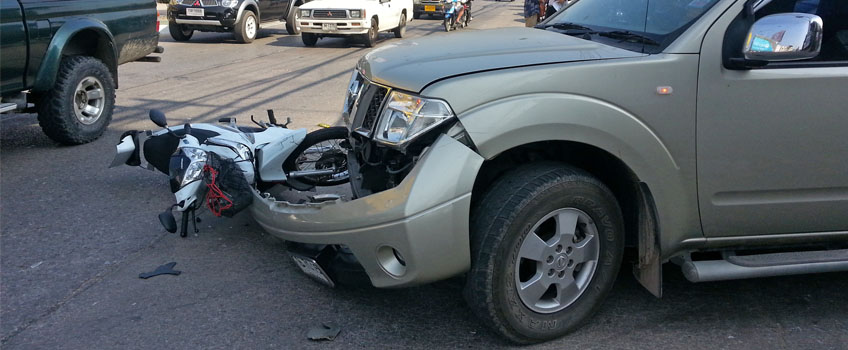
The Most Common Causes of Motorcycle Accidents in Binghamton NY
- Feb 8, 2024
- By: Tom Schimmerling
Riding a motorcycle can provide an unparalleled sense of freedom and adventure as you explore the open roads. However, operating a motorcycle also comes with serious safety risks. In fact, motorcyclists are roughly 28 times more likely to die in crashes compared to those in passenger cars. By understanding the most common causes behind motorcycle collisions in Broome County and the greater Binghamton region, riders can stay vigilant and help reduce risks.
Driver Distraction
The number one contributor to motorcycle crashes is distracted or inattentive automobile drivers. Over half of all multi-vehicle collisions involving a motorcycle are due to the other motorist failing to notice the motorcycle according to the National Highway Traffic Safety Administration (NHTSA). From mobile devices to rowdy passengers, cars have no lack of potential distractions to take the drivers’ eyes away from the road. Even quick glances away can cause a rider to go unnoticed, leading to a devastating collision.
Making matters worse, the narrow profile of a motorcycle means they appear further away, traveling slower in the visual field. With small frontal profiles, they are also easily hidden behind car pillars or mirrors. Their size makes judging distance and speed difficult for motorists. Together, these perceptual problems case motorists to dangerously misjudge closing speeds and distance.
Impaired Riding
Intoxicated riding accounts for a startling 41% of motorcyclist deaths in crashes where alcohol or drugs were detected based on NHTSA data. Both illegal substances and prescription medications can majorly slow reaction times, decrease coordination, and impair judgement. Even small amounts of alcohol can hugely increase risks, with amounts well under the 0.08% blood alcohol concentration legal limit can still be dangerous.
The impacts of drugs and alcohol can me much more catastrophic on two wheels, where even slight errors in vehicle control lead to devastating accidents. The complex task of balancing a motorcycle suffers profoundly when senses, reaction time, and judgement become impaired. Yet, the feeling of exposure to the open environment can cause many riders to experience a deceptive sense of invincibility. Together these factors lead intoxicated riders to make fatal errors in speed and handling.
Aggressive Riding and Speeding
While automobiles may fail to notice motorcycles, the same cannot be said of law enforcement. Aggressive riding behaviors like weaving through dense traffic and tailgating are not only dangerous but can also lead to expensive moving violations. The Governors Highway Safety Association names speed as a major factor in over one-third of all fatal motorcycle crashes.
Higher speeds dramatically reduce the riders reaction time should an emergency occur on the road ahead. Kinetic energy ramps up exponentially with velocity, meaning faster riders experience far more traumatic impact forces in a crash. High speeds also decrease the stability and handling of motorcycles, especially around curves.
Hazardous Road Conditions & Animals
The vulnerability of motorcycles also amplifies the risks when you add in poor road conditions. Rain, snow, ice, animals, and road debris all require heightened senses when riding a motorcycle. Additionally, riders fail to reduce speed sufficiently in wet weather leading to loss of control. Icy or snow-covered roads lead to slide-outs and falls that cars would be unlikely to experience. Even normal highways hazards like potholes, railroad crossings and metal covers require extra vigilance.
But hazardous conditions play an even larger role specific to cornering crashes. Sand, gravel and other debris drifting across curves reduce available traction right when it’s needed most to resist centrifugal forces during lean-angle cornering. Too much speed through compromised corners easily leads to traumatic low-side or high-side accidents. Any springtime rider who has experienced the dust and gravel on roads left over from a long Binghamton winter knows the sinking feeling of feeling your bike start to slide out from under you.
Insufficient Rider Training and Licensing
One-quarter of crashed riders involved in 2019 collisions were not properly licensed to operate their motorcycle according to the Motorcycle Safety Foundation (MSF). Licensing helps ensure a baseline level of competence met through testing. But rider training provides the skills to properly handle emergency situations. Insufficient investments here increase the risks of panic reactions, target fixations and other errors that amplify dangers when the unexpected occurs.
Passengers also contribute additional challenges for riders, especially around curves and braking. Extra training focused specifically on riding with passengers helps mediate additional risks created with extra weight onboard.
For new riders, Southern Tier Harley Davidson offers a “Learn to Ride” course to help new riders get comfortable on their bike, avoid accidents, and ride confidently.
Poor Judgement of Others on the Road
While car and truck drivers may struggle to detect motorcycles, the reverse also proves true. Motorcyclists often misinterpret the distances, velocities and intents of the drivers around them. Blind spots hidden from the rider's vantage point can also raise risks of collisions during merging and lane changes.
Unfortunately, tendencies towards overconfidence and inflated riding skill levels contribute towards poor safety margins as well. Riders that overestimate their emergency handling capabilities select smaller margins of error. But unexpected road events eventually push those error margins to the brink. Defensive riding requires realistic assessments of situational hazards to inform sufficient risk buffers chosen.
Even the Most Experienced Riders can Experience a Devastating Motorcycle Accident
Staying safe ultimately requires efforts from both riders and drivers to accommodate motorcycles through the traffic mix. But by understanding the most prominent risks, riders can ride defensively and work to mitigate potential hazards. Sustained training, protective gear, licensing and sober riding provide the basis for incident-free enjoyment of riding. If you’ve been involved in a motorcycle accident in the greater Binghamton region, call experienced motorcycle accident attorney Tom Schimmerling for a free consultation to find out if you may be eligible for compensation.




